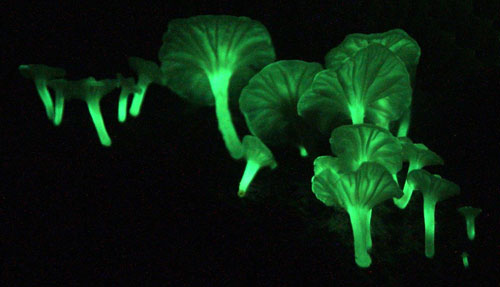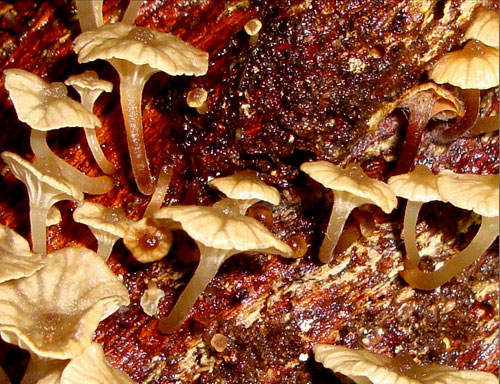Creature Feature: Bio-Luminescing Fungus
On one of his nightly walks through the jungle, BFREE Resident Biologist Dan Dourson stumbled upon what is now known to be quite a rare sight, the fruiting bodies (mushroom) of a bio-luminescing fungus species! The unlikely light source emanated from mushrooms growing out of a rotting cohune wood and aged seeds in BFREE’s organic cacao plantation.
Fungi, an interesting group of key organisms, facilitate decay of dead plant material, returning important nutrients to the ecosystem. The main body of any fungi, the mycelium (the bulk of the organism) is actually found living underground while the fruiting body or “mushroom” is the part most commonly seen and can be compared to the orange of a tree. While it is not uncommon for the mycelium to glow, it is exceptionally uncommon for mushrooms! Worldwide there are only 71 species known to possess this unique ability and one of them is right here at BFREE!
The mystery mushroom was identified to genus as a species of Mycena after sending images to a leading expert in bioluminescent mushrooms, Dr. Dennis Dejardin of San Francisco State University. These Mycena dubbed “Fairy-stools” emit a blue-green light that is an amazing experience to behold. At this very moment, dried specimens of this mushroom are enroute to Dr. Desjardin for further examination. Wouldn’t it be great if it turns out to be new to science?
The phenomenon of bioluminescence is natural light created by living organisms occurring in approximately 25 different phyla, many of which are entirely unrelated. Arthropods, certain crustaceans, several species of mollusks including the land snail Quantula striata from Malaysia, deep sea fish, marine microorganisms known as dinoflagellates, fungi and several varieties of slime molds all are known to possess this aerie quality. The most familiar animals in Belize possessing this unique power are the fireflies and headlight beetles whose light organs located on the abdomen and thorax regions of these insects are used to communicate and attract potential mates and in some cases, lure in prey to eat.
Several hypotheses of bioluminescence function in fungi include attracting hungry invertebrates which may aid in spore dispersal or used in attracting predators of mycetophagous invertebrates (organisms that eat mycelium). Some scientists speculate that glowing fungi are nothing more than by-products of some other metabolic process. In high elevation montane forests of the Maya Mountains, the jungle floor glows at night, a result of bioluminescent mycelium growing in decaying oak leaves and other decomposing vegetation.
Biological lighting differs from other light sources such as light bulbs and candlelight in being cool, producing little or no heat during illumination. Bioluminescent light is the result of a biochemical reaction during which two types of chemicals, luciferin and luciferase are combined together. The luciferase acts as an enzyme, allowing the luciferin to release energy as it is oxidized producing the light. There is ongoing research involving bioluminescence in the areas of evolution, ecology, histology, physiology, biochemistry, and biomedical applications.
So if you are wandering the jungles at BFREE at night (especially in the rainy season), take the time to turn off your headlamp and look around….you never know what might be glowing!



Dan
Way cool! As you probably know, we have a glowing mushroom in Ohio, the Jack-o-lantern (omphalotus oleraius), which is the poisonous look-alike to the Chanterelle family. However, I have never taken a night hike and actually seen this species glowing. You have motivated me to do this when the mushroom blooms later this year.
Cheers!
Mike
Excellent work, very interesting!
Thank you for sharing your knowledge!